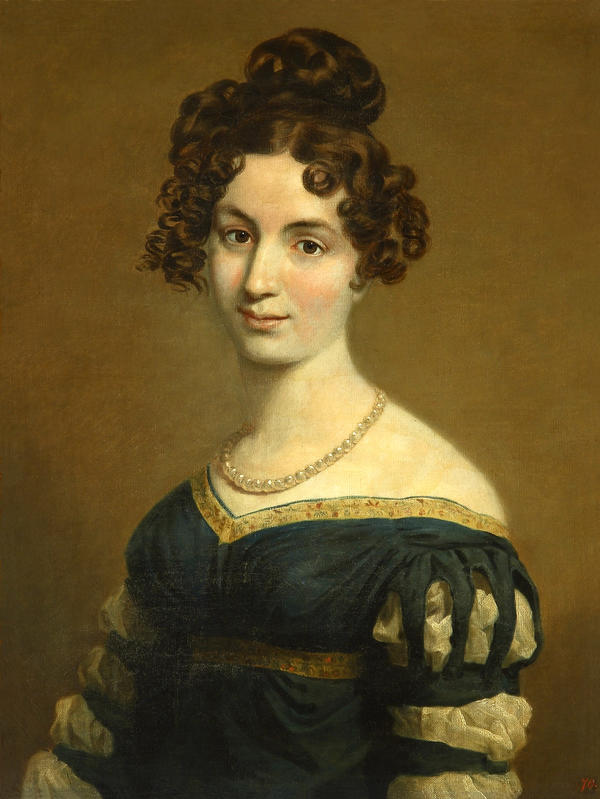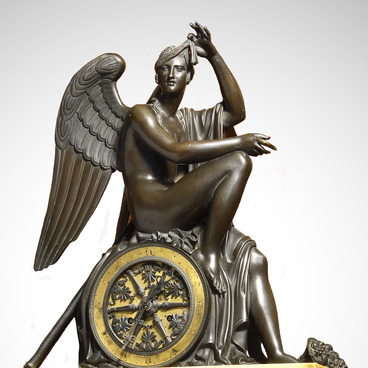Countess Elizabeth Branitskaya was born into the family of the Hetman of Poland, Xaveria Branitski. Her mother was Gregory Potemkin 's niece, Alexandra Engelhardt.
The Countess was raised strictly and lived in the village until the age of 27. It was not until 1819 that she went on her first journey abroad.
While traveling in France Elizabeth Xaviererievna met 37-year-old Count Mikhail Semisovich Vorontsov - a glorified combat general. In Paris, the Count proposed to Elizabeth’s and they married there. Making the wedding journey around Europe, the newly-weds visited London, where artist George Doe was popular at the time. Alexander, I invited Doe to paint a large series of portraits for the Military Gallery of 1812 at the Hermitage.
John Doe painted a portrait of Vorontsova. The Alupkin portrait was copied from Doe’s work.
A year later, the newly-weds returned to Russia. Due to the appointment of the Count as Governor-General of New Russia, the family moved to Odessa in 1823. The countess gathered a society of poets and artists in Odessa. Pushkin A.S. met her in 1823. On the pages of the manuscript of the novel ‘Eugene Onegin’, he painted the side-face of Elizabeth Ksaverievna. Researchers of Pushkin’s work counted more than thirty outlines in the poet’s diaries and letters. Pushkin’s “Odessa period” lasted 13 months, it reflected in love poems: “Mascot, ” Farewell, “Burned letter”.
After purchasing of Alupki estate by the Count, Vorontsov built a palace there. Elizabeth Xaviererievna independently created the design of the castle and the adjacent park. The Countess loved gardening and knew botany well. Vorontsova was engaged in construction of rosary and selection of roses.
Elizabeth Xaviererievna had an active lifestyle, she headed a сharity that helped the needy and orphans for many years. Her merits were highly appreciated at the court. She was granted a title of state lady in 1838 and was awarded the Order of Saint Catherine in 1850.
After the death of her beloved husband, she completely moved away from social life.
The portrait of Elizabeth Xaviererievna is in the Chinese Study. Her cute face, staring at the viewer, is framed with curls, a fashion trend of hairstyle in 1820. Countess is wearing a dark blue dress with high waist and cut puffs of sleeves: such dress is called “Venetian.” On the neck is a simple but must-have in the privileged circle pearl necklace, which emphasizes the whiteness of the skin. light, emphasizing the whiteness of the skin.
The Countess was raised strictly and lived in the village until the age of 27. It was not until 1819 that she went on her first journey abroad.
While traveling in France Elizabeth Xaviererievna met 37-year-old Count Mikhail Semisovich Vorontsov - a glorified combat general. In Paris, the Count proposed to Elizabeth’s and they married there. Making the wedding journey around Europe, the newly-weds visited London, where artist George Doe was popular at the time. Alexander, I invited Doe to paint a large series of portraits for the Military Gallery of 1812 at the Hermitage.
John Doe painted a portrait of Vorontsova. The Alupkin portrait was copied from Doe’s work.
A year later, the newly-weds returned to Russia. Due to the appointment of the Count as Governor-General of New Russia, the family moved to Odessa in 1823. The countess gathered a society of poets and artists in Odessa. Pushkin A.S. met her in 1823. On the pages of the manuscript of the novel ‘Eugene Onegin’, he painted the side-face of Elizabeth Ksaverievna. Researchers of Pushkin’s work counted more than thirty outlines in the poet’s diaries and letters. Pushkin’s “Odessa period” lasted 13 months, it reflected in love poems: “Mascot, ” Farewell, “Burned letter”.
After purchasing of Alupki estate by the Count, Vorontsov built a palace there. Elizabeth Xaviererievna independently created the design of the castle and the adjacent park. The Countess loved gardening and knew botany well. Vorontsova was engaged in construction of rosary and selection of roses.
Elizabeth Xaviererievna had an active lifestyle, she headed a сharity that helped the needy and orphans for many years. Her merits were highly appreciated at the court. She was granted a title of state lady in 1838 and was awarded the Order of Saint Catherine in 1850.
After the death of her beloved husband, she completely moved away from social life.
The portrait of Elizabeth Xaviererievna is in the Chinese Study. Her cute face, staring at the viewer, is framed with curls, a fashion trend of hairstyle in 1820. Countess is wearing a dark blue dress with high waist and cut puffs of sleeves: such dress is called “Venetian.” On the neck is a simple but must-have in the privileged circle pearl necklace, which emphasizes the whiteness of the skin. light, emphasizing the whiteness of the skin.



